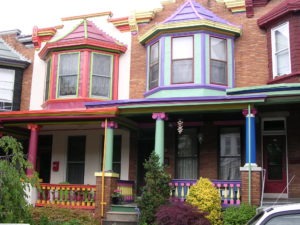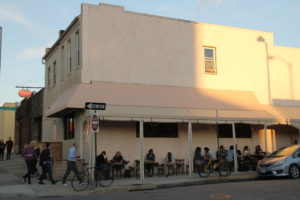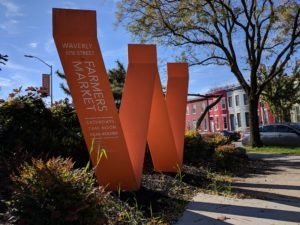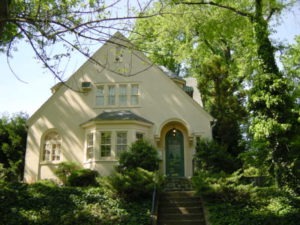5 Beautiful North Central Baltimore Neighborhoods
From the Blog
With a variety of housing stock, many neighborhood amenities and close proximity to major employers it’s easy to see why residents love living in North Central Baltimore.
“There is no cliche in saying that Central Baltimore has something for everyone,” said Jack Danna, Director of Commercial Revitalization for Central Baltimore Partnership. “Whether you are looking for the energy and the cultural pulse of the Station North Arts District or the calm and pleasant sounds of kids playing at one of the area’s many wonderful playgrounds, the City’s only year-round farmers market or the best housing stock in the city—Central Baltimore is where everything is happening in a walkable and pedestrian-friendly environment.”
Shop for your weekly groceries at the Waverly Farmers Market before spending the day at the Baltimore Museum of Art and catching a show at the historic Parkway Theatre. It’s all part of a great day in the neighborhood! Are you looking for your next home in Baltimore? Here are five North Central Baltimore neighborhoods you may want to consider.
Oakenshawe
Oakenshawe residents love their cozy, human-scaled streets, leafy parkways and lush yards. The friendly, active neighborhood offers single-family detached homes with smaller footprints than its surrounding neighborhoods—perfect for those looking for lower prices and less maintenance! Its prime location close to Waverly Farmer’s Market, the Waverly Branch public library, Johns Hopkins University’s Homewood campus, the St. Paul business district, and the Baltimore Museum of Art offers all the amenities of vibrant, active city life within a small, leafy “suburb.”
Built between 1916 and 1925, Oakenshawe is one of Baltimore City’s earliest “streetcar suburbs,” built primarily on Henry Wilson’s former ample estate. Its 337 houses were laid out like English garden suburbs in terraces using Georgian Revival building materials — red brick, gray slate roofs and detailed moldings. The neighborhood is listed on the National Register of Historic Places, which gives homeowners access to tax credits to restore homes with historically appropriate materials.
Charles Village
Charles Village is a primarily residential neighborhood made up of unique rowhomes built along a strict grid pattern. Homes feature eclectic architectural elements like Dutch gables and conical roofs. Many homes have stained glass windows with transoms and small, front porches. Close to Johns Hopkins University and the Baltimore Museum of Art, the neighborhood offers convenience right in the heart of the city.
“The low cost of living that makes many things possible [and] running into people I know everywhere I go, especially the Waverly/32nd Street Saturday Farmers Market” are the highlights for resident Max Romano.
Charles Village has played an important role in the development of North Central Baltimore. It can be considered the northernmost extension of Baltimore’s finest rowhouse neighborhoods which first developed at Mount Vernon Place and expanded northward along the Charles Street corridor. The architecture of Charles Village represents a cross section of late nineteenth to early twentieth century rowhouses, individual homes and apartments that provide the pivotal transition between the heavily urbanized neighborhoods to the south and the garden suburbs of Guilford, Homeland and Roland Park to the north.

Remington
This original streetcar suburb is best known for being a relaxed community of old timers, artists, musicians, professionals and students. After a long period of decline it is in the midst of a major resurgence as new residents and businesses are drawn to Remington‘s affordability and central location. Residents enjoy a variety of great restaurants and entertainment options, ample parks and green space, and a variety of different living arrangements, from tiny rowhouses to large, loft-style apartments.
Come to Remington to choose from rowhouses at an attractive median home price of $172,500 or various apartment rentals. Stay for the queso fundido at Bar Clavel and other tasty spots in the neighborhood like R. House and W.C. Harlan.
Wyman Park
Often mistaken for Hampden, Wyman Park is a small strip of a neighborhood between the Johns Hopkins Homewood campus and Hampden proper. The quiet, mostly residential neighborhood is a great choice for those looking to be close enough to The Avenue’s retail and restaurant offerings while coming home to something a little less busy.
Runners, joggers and families with children will enjoy the offerings of Wyman Park along the eastern boundary of the neighborhood. The namesake green space is the perfect spot for recreation or dog walking!
“I really love our neighborhood for its walkability, park space, festivals and easy access to fun shops and restaurant,” Wyman Park resident Daphne Reinhart told us.

Abell
Named in honor of Baltimore Sun founder A.S. Abell and the avenue that bears his name, the Abell Community comprises nine square blocks in the heart of Baltimore city. Known for its vibrantly-colored ‘Painted Lady’ rowhouses, the community is almost entirely residential and features tree-lined streets, historic architecture and an active, close-knit community. Residents love their annual events—including a New Year’s Eve progressive dinner and the Abell Community Street Fair.
“Our neighbors and friends here are friendly, down-to-earth and often as committed to city living as we are,” said Abell resident Laura Scott. “We also appreciate the beauty of the unique architecture, the strong sense of community among people who have lived here for generations and have deep connections to the city’s history, as well as the sense of connectedness to we feel to the whole city—this really is “Smaltimore.”
Do you want to explore more Baltimore City neighborhoods? Read more about them on our Neighborhoods page.

- Save your recommendations for later.
- Get access to our Financial Incentives Tool.
- Connect with a Live Baltimore staff member for a one-on-one consultation.
- Get a free I ♥ City Life bumper sticker.

- Save your recommendations for later.
- Get access to our Financial Incentives Tool.
- Connect with a Live Baltimore staff member for a one-on-one consultation.
- Get a free I ♥ City Life bumper sticker.
